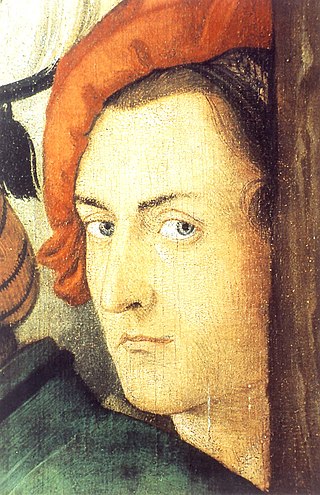
Hans Baldung, called Hans Baldung Grien,, was a painter, printer, engraver, draftsman, and stained glass artist, who was considered the most gifted student of Albrecht Dürer and whose art belongs to both German Renaissance and Mannerism.
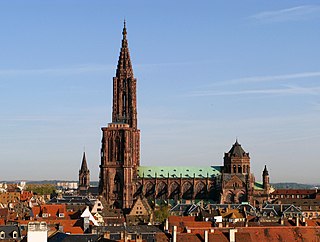
Strasbourg is the prefecture and largest city of the Grand Est region of eastern France. Located at the border with Germany in the historic region of Alsace, it is the prefecture of the Bas-Rhin department. It is the official seat of the European Parliament.

The Germanisches Nationalmuseum is a museum in Nuremberg, Germany. Founded in 1852, it houses a large collection of items relating to German culture and art extending from prehistoric times through to the present day. The museum is Germany's largest museum of cultural history. Out of its total holding of some 1.3 million objects, approximately 25,000 are exhibited.

The Musée de l'Œuvre Notre-Dame is the city of Strasbourg's museum for Upper Rhenish fine arts and decorative arts, dating from the early Middle Ages until 1681. The museum is famous for its collection of original sculptures, glass windows, architectural fragments, as well as the building plans of Strasbourg Cathedral. It has a considerable collection of works by Peter Hemmel von Andlau, Niclas Gerhaert van Leyden, Nikolaus Hagenauer, Ivo Strigel, Konrad Witz, Hans Baldung and Sebastian Stoskopff.

The Musée des Beaux-Arts de Strasbourg is the old masters paintings collection of the city of Strasbourg, located in the Alsace region of France. The museum is housed in the first and second floors of the baroque Palais Rohan since 1898. The museum displays works by non-Upper Rhenish artists from between the 14th century and 1871 and by Upper Rhenish artist from between 1681 and 1871. The museum owned 1,934 works as of 31 December 2015, this number has substantially increased since. The old masters from the upper-Rhenish area until 1681 are exhibited in the neighboring Musée de l’Œuvre Notre-Dame.

Musée Tomi Ungerer/Centre international de l’illustration is a museum in Strasbourg in the Bas-Rhin department of France. Opened in November 2007, it is dedicated to the work of Strasbourg-born artist Tomi Ungerer and displays 11,000 graphic works of all kind by Ungerer and some of his most famous colleagues as well as Ungerer's large collection of ancient toys and regular, special exhibitions.
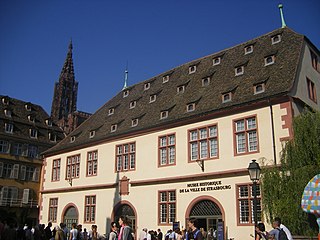
The Musée historique is a museum in Strasbourg in the Bas-Rhin department of France. It is located in the Renaissance building of the former slaughterhouse and is dedicated to the tumultuous history of the city from the early Middle Ages until the contemporary period.
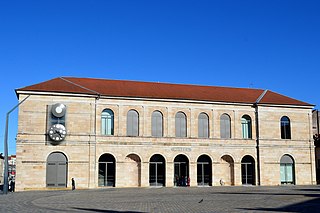
The musée des Beaux-Arts et d'Archéologie in the French city of Besançon is the oldest public museum in France. It was set up in 1694, nearly a century before the Louvre became a public museum.

Hieronymus Wierix (1553–1619) was a Flemish engraver, draughtsman and publisher. He is known for his reproductive engravings after the work of well-known local and foreign artists including Albrecht Dürer. Together with other members of the Wierix family of engravers he played an important role in spreading appreciation for Netherlandish art abroad as well as in creating art that supported the Catholic cause in the Southern Netherlands.

Pierre-François Basan was a French engraver, editor, and print seller.

Étienne Martellange was a French Jesuit architect and draftsman. He travelled widely in France as an architect for the Jesuit order and designed more than 25 buildings, mostly schools and their associated chapels or churches. His buildings reflect the Baroque style of the Counter-Reformation and include the Chapelle de la Trinité in Lyon and the church of Saint-Paul-Saint-Louis in Paris. In the course of his travels he made almost 200 detailed pen drawings depicting views of towns, buildings and monuments. These pictures have survived and provide an important historical record of French towns in the first third of the 17th century.
The Master of the Drapery Studies, also known as Master of the Coburg Roundels is the notname given to the "very productive" and "multifaceted" late 15th-century author of some 30 surviving paintings and over 150 surviving drawings. Indeed, according to the J. Paul Getty Museum, up to 180 surviving drawings "have been attributed to this master, comprising one of the most extensive bodies of drawn work of any northern European artist before Albrecht Dürer." Conversely, it has been suggested at least once that both the Master of the Drapery Studies and the Master of the Coburg Roundels may be two separate persons and that their body of work is attributable to a whole circle of artists.

Jules Théophile Schuler was a French painter and illustrator in the Romantic style. He gave his name to an art award established in 1938.

The Musée des beaux-arts du Locle, located in the canton of Neuchâtel in the Switzerland, organizes temporary exhibitions three times a year. Showcasing prints, photographs, installations and paintings, solo and thematic exhibitions take place in a 2,000 m2 space. These exhibitions of Swiss and international art, past and present, highlight both emerging and established artists. Open to all techniques and mixed media in particular, MBAL also organises the Triennale de l'art imprimé contemporain .

Everhard or Eberhard Jabach was a French businessman, art collector, and director of the French East India Company. He was born in Cologne in the Holy Roman Empire but later naturalised as a French subject.
Cathryn Boch, is a French award-winning artist who lives and works in Marseille. She won Drawing Now Prize in 2014. She obtained many residencies abroad and exhibited at key galleries and museums, including MAMCO Geneva in 2009.

Louise-Adéone Drölling, also known as Madame Joubert was a French painter and draughtswoman. Both her father, Martin Drolling, and her older brother, Michel Martin Drolling, were celebrated artists in their day.
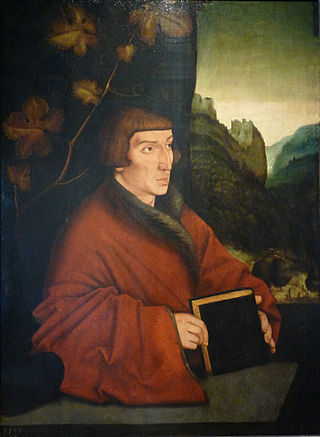
Ambrosius Volmar Keller is a 1538 portrait painting by the German Renaissance artist Hans Baldung. The painting was offered to the city of Strasbourg by German Emperor Wilhelm II, from his private collection, in 1890. It is on display in the Musée de l'Œuvre Notre-Dame. Its inventory number is MBA 191.

The Witches is a chiaroscuro woodcut by German Renaissance artist Hans Baldung. This woodcut depicts witches preparing to travel to a Witches' Sabbath by using flying ointment. This is the first woodcut produced by Baldung after leaving the studio of his mentor, Albrecht Dürer, and one of the first Renaissance images to depict both witches that fly and a Witches' Sabbath.


















